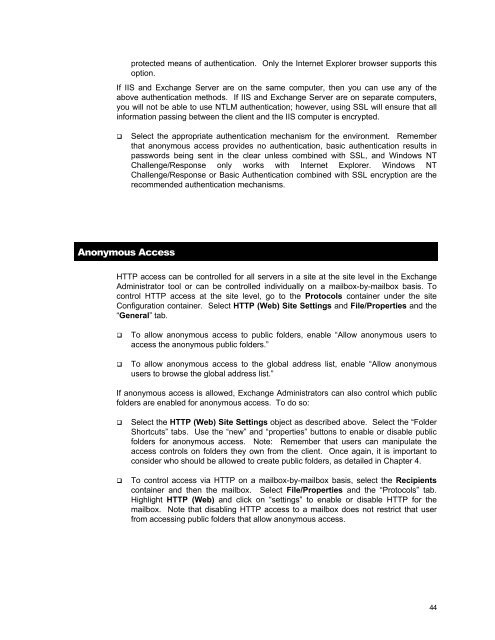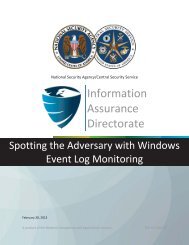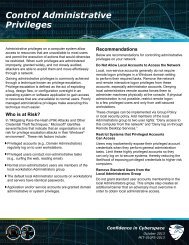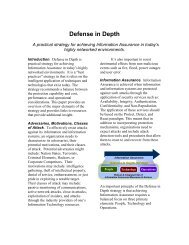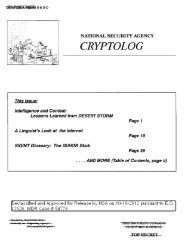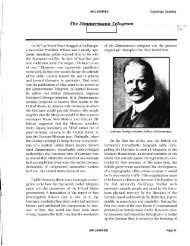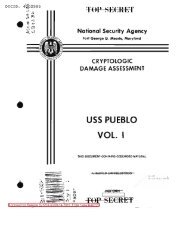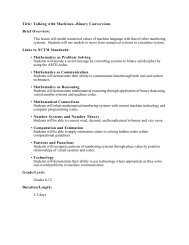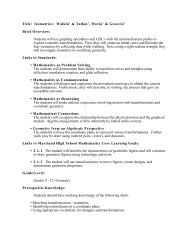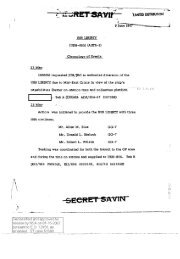Guide to the Secure Configuration and Administration of Microsoft ...
Guide to the Secure Configuration and Administration of Microsoft ...
Guide to the Secure Configuration and Administration of Microsoft ...
Create successful ePaper yourself
Turn your PDF publications into a flip-book with our unique Google optimized e-Paper software.
protected means <strong>of</strong> au<strong>the</strong>ntication. Only <strong>the</strong> Internet Explorer browser supports this<br />
option.<br />
If IIS <strong>and</strong> Exchange Server are on <strong>the</strong> same computer, <strong>the</strong>n you can use any <strong>of</strong> <strong>the</strong><br />
above au<strong>the</strong>ntication methods. If IIS <strong>and</strong> Exchange Server are on separate computers,<br />
you will not be able <strong>to</strong> use NTLM au<strong>the</strong>ntication; however, using SSL will ensure that all<br />
information passing between <strong>the</strong> client <strong>and</strong> <strong>the</strong> IIS computer is encrypted.<br />
Select <strong>the</strong> appropriate au<strong>the</strong>ntication mechanism for <strong>the</strong> environment. Remember<br />
that anonymous access provides no au<strong>the</strong>ntication, basic au<strong>the</strong>ntication results in<br />
passwords being sent in <strong>the</strong> clear unless combined with SSL, <strong>and</strong> Windows NT<br />
Challenge/Response only works with Internet Explorer. Windows NT<br />
Challenge/Response or Basic Au<strong>the</strong>ntication combined with SSL encryption are <strong>the</strong><br />
recommended au<strong>the</strong>ntication mechanisms.<br />
Anonymous Access<br />
HTTP access can be controlled for all servers in a site at <strong>the</strong> site level in <strong>the</strong> Exchange<br />
Administra<strong>to</strong>r <strong>to</strong>ol or can be controlled individually on a mailbox-by-mailbox basis. To<br />
control HTTP access at <strong>the</strong> site level, go <strong>to</strong> <strong>the</strong> Pro<strong>to</strong>cols container under <strong>the</strong> site<br />
<strong>Configuration</strong> container. Select HTTP (Web) Site Settings <strong>and</strong> File/Properties <strong>and</strong> <strong>the</strong><br />
“General” tab.<br />
To allow anonymous access <strong>to</strong> public folders, enable “Allow anonymous users <strong>to</strong><br />
access <strong>the</strong> anonymous public folders.”<br />
To allow anonymous access <strong>to</strong> <strong>the</strong> global address list, enable “Allow anonymous<br />
users <strong>to</strong> browse <strong>the</strong> global address list.”<br />
If anonymous access is allowed, Exchange Administra<strong>to</strong>rs can also control which public<br />
folders are enabled for anonymous access. To do so:<br />
Select <strong>the</strong> HTTP (Web) Site Settings object as described above. Select <strong>the</strong> “Folder<br />
Shortcuts” tabs. Use <strong>the</strong> “new” <strong>and</strong> “properties” but<strong>to</strong>ns <strong>to</strong> enable or disable public<br />
folders for anonymous access. Note: Remember that users can manipulate <strong>the</strong><br />
access controls on folders <strong>the</strong>y own from <strong>the</strong> client. Once again, it is important <strong>to</strong><br />
consider who should be allowed <strong>to</strong> create public folders, as detailed in Chapter 4.<br />
To control access via HTTP on a mailbox-by-mailbox basis, select <strong>the</strong> Recipients<br />
container <strong>and</strong> <strong>the</strong>n <strong>the</strong> mailbox. Select File/Properties <strong>and</strong> <strong>the</strong> “Pro<strong>to</strong>cols” tab.<br />
Highlight HTTP (Web) <strong>and</strong> click on “settings” <strong>to</strong> enable or disable HTTP for <strong>the</strong><br />
mailbox. Note that disabling HTTP access <strong>to</strong> a mailbox does not restrict that user<br />
from accessing public folders that allow anonymous access.<br />
44


